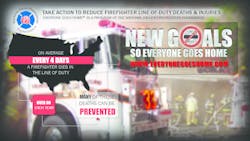The inside of a burning building is not the most dangerous location for firefighters. If you’re familiar with statistics about firefighter deaths and injuries, you will recognize a more dangerous location is the road. Vehicular incidents are the second-leading cause of firefighter fatalities (second to heart attacks and strokes). Transportation trauma for firefighters can occur before leaving the station, while driving to or from a fire, arriving on the scene of, or cleaning up from, a crash, or even staging apparatus at an incident. In each of these scenarios, firefighters are vulnerable to traumatic events if precautions aren’t taken and protocols followed.
These issues, along with concerns about inadequate training for driving heavy and specialized apparatus, were discussed during TAMPA2.
To begin, the group considered how one click has the power to change everything in your life in an instant. They didn’t mean the click of a mouse or the clicks of the keys on a laptop. The focus was on the click of a seatbelt.
If the general public understands phrases like “seatbelts save lives”—and follows through—then why aren’t firefighters doing the same? For many years the answer was simple; the belts didn’t fit around the gear. But manufacturers have worked with the fire service and over time modifications have been made. We’re now at a point when wheels should not roll unless everyone is securely belted, and this goes for department apparatus and personal vehicles.
The power of that one click was on display at FRI 2015 in Atlanta. The twisted steel and broken frame of the City of Atlanta Fire Department’s engine caught nearly everyone’s attention. I’m certain many paused, wondering about the fate of the crew, and feeling relieved to learn that all four firefighters suffered only minor injuries.
They survived this crash because they knew what to do before leaving the station to respond to a house fire. They buckled up.
Complete compliance
Everyone at TAMPA2 agreed that our goal should be to have 100 percent compliance by all firefighters at all times. Strategies to achieve this included updating NFPA standards to require seatbelt use and creating model legislative language mandating their use. Adopting the NFFF Seatbelt Pledge is a great step, if you haven’t done that already.
Aside from using belts correctly, there are other concerns about operating equipment and apparatus correctly. How can we ensure that individuals are adequately trained, certified or qualified to drive and operate emergency vehicles safely and competently?
The attendees at TAMPA2 agreed that national standards for training, annual competency evaluations and enforcing vehicle-licensing requirements are first steps. Other suggestions included mandating national traffic incident management (NTIM) training and placing fire service representatives on state Department of Transportation committees.
Beyond these issues, it’s critical to assess how we respond. As firefighters, we are called upon to help others during what could literally be their very worst day. Therefore, we must make the extra effort to do everything in our means to respond appropriately.
When a call comes in, nearly every firefighter still feels that rush of adrenaline that triggers that sense of immediacy. But that willingness to respond at a moment’s notice can interfere with our ability to lead effectively and act responsibility. Driving recklessly at high speeds is putting more people—from our crew to innocent people on the streets—at risk.
The attendees at TAMPA2 agreed that departments should identify best practices for hot and cold responses and adopt—and adhere to—risk-based emergency response procedures. In other words, clarify acceptable speeds and driving strategies when navigating the streets and hold everyone to these standards. And reiterate them frequently.
Situational Awareness
Furthermore, situational awareness upon arrival is essential. Each year more firefighters, EMS workers and police officers are struck while working an incident. Drivers are often gawking at the scene rather than avoiding it or possibly they are texting. We’re there to protect and serve the community and each other. After strategically placing apparatus to block and protect everyone on the fireground or crash site, traffic slowing/control devices also must be placed properly to alert oncoming traffic of any obstacles. And remember that even if you can see someone approaching, they may not see you. Always wear reflective traffic safety vests.
The most frequent theme from all of the discussions at TAMPA2 applies well to transportation issues: Make personal accountability the priority. Doing so on every response can save your life and the lives of your fellow firefighters.
About the Author

Ronald Siarnicki
National Fallen Firefighters Foundation
Fire Chief Ronald Jon Siarnicki began his career as a firefighter with the Prince George's County Fire/EMS Department in 1978 and with 24 years of fire, rescue, and emergency medical services operational experience, he has progressed through the ranks to Chief of the Department. In this position he served as the Chief Executive Officer responsible for the fire, rescue and emergency medical services of Prince George's County, Maryland. In July of 2001, Chief Siarnicki retired from the Prince George?s County Fire/EMS Department to take the position of Executive Director of the National Fallen Firefighters Foundation in July of 2001. He is a graduate of the Masters Program, School of Management and Technology, at the University of Maryland, University College, College Park, Maryland and has a Bachelor of Science Degree in Fire Science Management from UMUC. He is a certified Fire Officer IV, Fire Fighter Level III, and State Emergency Medical Technician. He has served as a UMUC faculty member for the Fire Science Curriculum since 1997.
